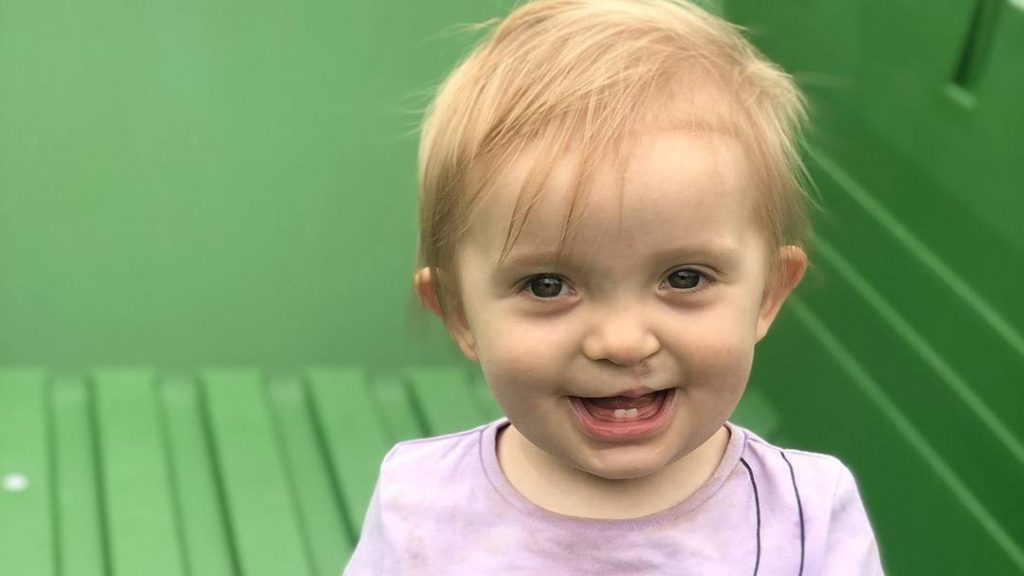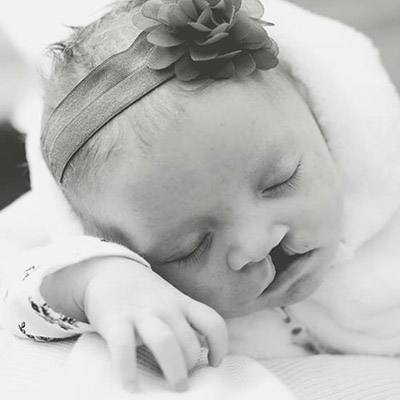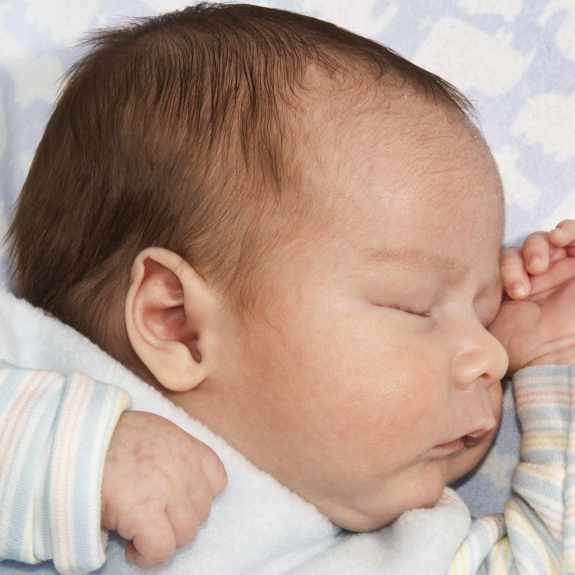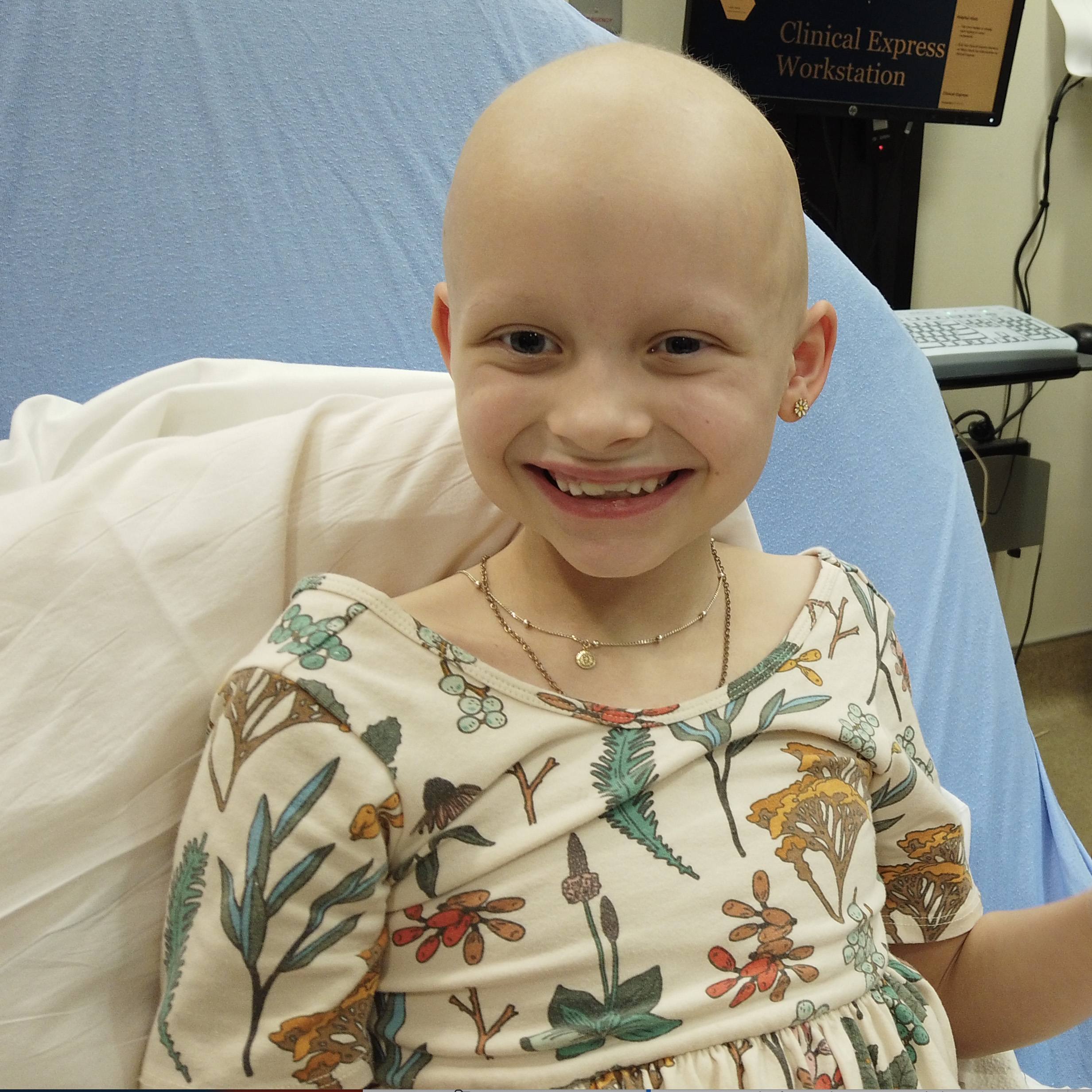-
Children's Center
Sharing Mayo Clinic: The wide, wonderful smiles of a Warrior Princess

For Rebecca and J Winkowski, learning that their daughter, Everly, would be born with a cleft lip and palate was an unexpected and unnerving discovery. But after meeting a compassionate team of Mayo Clinic physicians committed to Everly's care, those feelings of anxiety and apprehension quickly vanished.
Rebecca and J Winkowski have several nicknames for their 1-year-old, Everly. Babyzilla, because she gets into everything, is one of them. Another term of endearment the Millville, Minnesota, residents have for their youngest child is Warrior Princess for the many medical challenges she's faced since birth.
Affected by cleft lip and cleft palate, Everly's condition was discovered in utero. Just one week after entering the world on Oct. 1, 2018, at Mayo Clinic in Rochester, she began wearing an orthodontic device to reshape her gums and lips. At 3 months old, Everly underwent her first facial surgery and, eight months later, underwent a second.
Despite the ongoing medical intrusions into her life, Everly is a happy, smiley girl. "She just blows my mind," Rebecca says. "Through everything, she's been the happiest little lady. She is so fun, and it just doesn't seem to faze her."
Affecting approximately 1 in 1,000 babies, cleft lip and palate is the second most common birth defect. Everly, like all children born with this condition, will require ongoing treatment. But thanks to the commitment of a team of physicians at Mayo's Cleft and Craniofacial Clinic, the family has been able to navigate the journey well.
From the obstetrical care Rebecca received from Mari Charisse Trinidad, M.D., before Everly's birth, to the help provided by orthodontists John Volz, D.D.S. and Chad Rasmussen, D.D.S., when Everly was a newborn, to the corrections made by surgeon Shelagh Cofer, M.D., the care at Mayo Clinic was kind, thoughtful and individualized.
"The people who've helped us, they've all been great," Rebecca says. "Whenever she was having issues … they immediately got us in the office the next day. They immediately addressed any of our issues. Everyone was on top of it. They went above and beyond."
Compassionate, knowledgeable care
Everly's team at Mayo Clinic began forming around the little girl before she was born. It started with support from Dr. Trinidad in the Department of Obstetrics and Gynecology. "I'm a mom who likes all the answers and am kind of an information junkie," Rebecca says. "Dr. Trinidad spent so much time walking me through the things that could happen — the good, the bad and the ugly."
Rebecca learned that in children with cleft lip and palate, the severity of the condition can vary significantly. They wouldn't have a full grasp on Everly's condition until she was born.
"Clefts can be all sorts of different clefts. Sometimes it just involves the lip itself. Other times, the separation goes into the nose, and sometimes it extends into the palate," explains Dr. Volz, who met Everly when she was just a few days old.
"The first three months are critical to take the deformed nasal cartilage from a concave shape to convex."
Chad Rasmussen, D.D.S.
When she was born, the team found that Everly's cleft was unilateral, or one-sided, affecting the left half of her mouth. It involved her lip, nose and palate, and resulted in a separation of her upper lip that extended past her nose and into the back of her mouth, creating an opening in the roof of her mouth.
For children with clefts, the biggest concern is their ability to eat. Although Rebecca attempted to breastfeed Everly, the gap in the infant's upper lip and mouth prevented her from forming a strong enough suction to nurse successfully. The infant could, however, eat from a special-needs bottle. So Rebecca pumped, and Everly still benefitted from her mother's breastmilk.
During Dr. Volz's first visit with Rebecca and J, he told them about the orthodontic device recommended for children with clefts. Called a nasoalveolar molding, or NAM, device, the retainer-like insert helps close the gap created by the cleft through regular adjustments. The appliance is secured in place with tape affixed to the child's cheeks. The child wears it 24/7 for three months.

It is important to fit cleft-affected babies with nasoalveolar molding devices as soon as possible. "When a baby is born, the estrogen level is high. Estrogen levels affect collagen and make it more moldable," Dr. Rasmussen says. "The first three months are critical to take the deformed nasal cartilage from a concave shape to convex."
Initially, it was difficult to tape the device into Everly's mouth, Rebecca says. "You feel awful — like you are just torturing your child. It seems barbaric to put this huge thing in their mouths and tape it in." But after a few weeks, Everly became upset when the device wasn't in her mouth. "She did better when she had it in," Rebecca says. "And by the end, she didn't want to eat without it."
Each week, from October to early January, Rebecca and J brought Everly to the Department of Dental Specialties to have the device adjusted. Over time, the reshaping effect of the device on Everly's mouth plateaued. "She is such a stinker and would just smile and pop it out of her mouth," Rebecca says. "At that point, we knew she was ready for surgery."
Surgery creates sweet smiles
On Jan. 10, Everly's first surgery to repair the cleft was performed by Dr. Cofer, who'd met the family for a prenatal consult before Everly was born. During the surgery, Dr. Cofer took advantage of Everly's reconfigured tissues to reconstruct a new upper lip and left nostril.
"We want to restore form and function, so when we have to do a repair, we repair it in layers," Dr. Cofer says. "We all have a circular muscle that goes all the way around our lips, and we have to repair that muscle. Then we try to create symmetry — we like to make that nice little cupid's bow of the lip — and repair the inside of the lip. Then we do the initial repair of the nose, trying to create symmetry and a functional nostril on the cleft side."
Everly's first surgery went well. "She was her happy little self pretty much right away," Rebecca says. "We got smiles in the hospital."
Immediately after surgery, Everly was able to drink from a bottle. But it was challenging because she needed to relearn how to eat using just her tongue. Whereas the nasoalveolar molding device created a false roof of her mouth, after surgery, the hole in her palate remained uncovered, allowing fluid to pass into and out of her nose.
"That was the hardest part for me — watching her eat," Rebecca says. "She wanted to eat. But every time she tried to eat something, it would come out her nose. I'm sure it would hurt her or stung her nose."
For the next several months, while Everly's lip and nose healed, Rebecca and J worked with her on learning how to drink out of a spoutless sippy cup — an important requirement for the palate repair surgery.
"The cleft palate repair goes all the way to the front of the gumline, and we don't want them to be using that area," Dr. Cofer says. "We prefer the baby be on a free-flowing sippy cup where they're not having a bottle nipple sticking into her mouth to interrupt the repair."
Near the end of August, when Everly was 11 months old, she was ready for her second surgery. Also performed by Dr. Cofer, this operation involved closing both the hard and soft parts of Everly's upper palate. "It's just like a jigsaw puzzle," Dr. Cofer says. "You get to figure out how it's all going to fit back together. Usually, all the elements are there. You just have to rearrange it to close the hole in the palate until it fits."
"I can't say enough about Dr. Volz and Dr. Rasmussen. They feel like family. The same thing for Dr. Cofer. I asked her a million questions and used the (patient) portal a lot."
Rebecca Winkowski
Following the second surgery, with the hole in the roof of her mouth sealed, Everly had to relearn how to breathe and eat. The initial few days were challenging, and Everly was limited to syringe feeding and a liquid diet for two weeks, but she recovered quickly.
"She was excited to eat," Rebecca says. "She likes to chew on things and wants to eat everything. Once we got to the point where she could chew food, I could tell that she was more satisfied. Crackers and veggie straws are her jam. And she loved her smash cake for her birthday."
Teamwork produces a happy ending
For Rebecca and J, seeing the change in Everly's features has been stunning. "I look at her mouth now and see no suture lines down the center," Rebecca says. "It's insane. She looks amazing. She is so cute."
It gives the family peace of mind to know that the medical team responsible for such a dramatic change in their daughter will continue to help them manage any issues with hearing, speech or abnormal tooth formation that could arise as a result of the cleft.

"I can't say enough about Dr. Volz and Dr. Rasmussen. They feel like family," Rebecca says. "The same thing for Dr. Cofer. I asked her a million questions and used the (patient) portal a lot. They've been really quick to answer questions and give me the resources, so I could be more confident because this was completely new territory."
Everly's medical team members say that her parents are as much to credit for the child's outcome as they are. "They're just amazing at their care and their love that they give to Everly. They are the reason she is thriving," Dr. Cofer says. "We're her team. We're here for her. But we work with the parents just as much as they work with us. She's a lucky girl to have such great parents."
HELPFUL LINKS
- Check out the Cleft and Craniofacial Clinic.
- Learn more about Pediatric Otorhinolaryngology and the Department of Dental Specialties.
- Visit Mayo Clinic Children's Center.
- Explore Mayo Clinic.
- Request an appointment.
Related Articles







